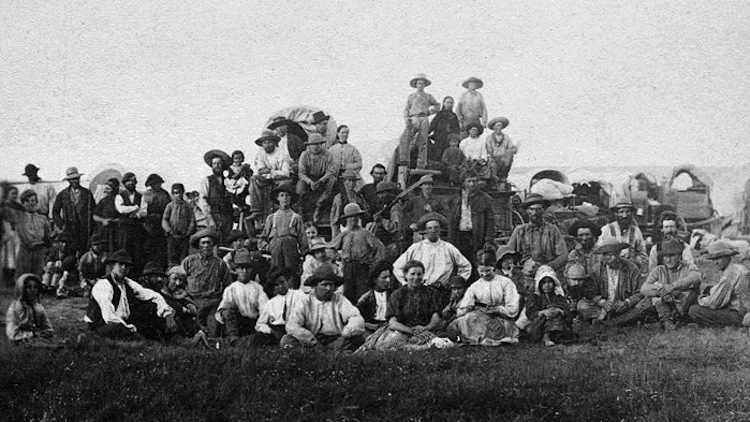Going West Wasn't So Deadly for Early Mormon Pioneers

Snakebites. Disease. Wolves. Exposure.
Pioneers who headed West during the 1800s had plenty to fear, but a new study finds that at least one group of these migrants — early Mormons — did just fine on their trek to Salt Lake City.
An analysis of historical records reveals that the mortality rate for early Mormon pioneers was a mere 3.5 percent, hardly higher than the national mortality rate at the time. The average American between the 1840s and 1860s, when the Mormon pioneers were heading West, had between a 2.5 percent and 2.9 percent chance of dying in a given year. [The Top 10 Leading Causes of Death]
"This is one of the first definitive analyses with the most up-to-date data regarding how many people were in this immigration, how many pioneers died and the breakdowns of these deaths," study researcher Dennis Tolley, a statistician at Brigham Young University in Provo, Utah, said in a statement.
Mormon migration
Joseph Smith founded the Church of Jesus Christ of Latter-day Saints (or LDS Church) in 1830. Smith and his followers were often discriminated against, and Smith himself was killed by a mob in 1844.
The founder's successor, Brigham Young, organized the fledgling religious group, calling for a western migration into what was then Mexico and what is now Utah. Between 1847 and 1868, more than 60,000 Mormons made the journey, according to LDS Church history. Many traveled by wagon train; a few walked, carrying their belongings (and sometimes their family members) in wheelbarrow-like handcarts.
Sign up for the Live Science daily newsletter now
Get the world’s most fascinating discoveries delivered straight to your inbox.
These handcart travelers provide some of the most harrowing tales of the migration. Ten groups of handcart-toting pioneers made the journey to Salt Lake City between 1856 and 1860, according to church histories. Eight arrived more or less safely. The two largest, the Willie and Martin handcart companies, met with a disaster that rivaled that of the infamous "Donner Party," a group of (non-Mormon) pioneers who became stranded in California in 1846 and resorted to cannibalism.
James G. Willie and Edward Martin led 500 and 665 pioneers, respectively. The groups got a late start, however, and didn't leave the area that is now Omaha until August. By October, the companies were stranded in Wyoming, dying of cold, hunger and disease. Rescue parties from Salt Lake City saved many, but more than 200 people lost their lives.
Safe travels
The story of the Willie and Martin companies is a tragic one, and modern Mormons often memorialize it with recreations of short handcart journeys. But only 5 percent of Mormon pioneers made the passage West by handcart, Tolley and his colleagues said in a statement.
"The [Mormon] youth go out and learn that a lot of people died, and they push the handcart, and after three days they think they are practically dead,” study researcher and retired LDS Church historian Mel Bashore said in the statement. "But most people traveled in wagons to Utah. The whole Mormon trail movement that spanned 20 years was a really successful endeavor."
Bashore and Tolley analyzed 56,000 records of pioneers who traveled to Salt Lake City between 1847 and 1868. The researchers found 1,900 deaths during the journey or within the calendar year of arrival in Salt Lake, making the overall mortality rate 3.5 percent.
Disease was a major killer, followed by accidents such as being trampled by livestock or run over by a wagon, the researchers reported. Four pioneers were killed by Native Americans; two died from snakebites or scorpion stings; one was murdered, and two were — yikes — eaten by wolves.
Taken alone, the Willie and Martin companies had a 16.5 percent mortality rate, and handcart travel in general was more perilous than journeying by wagon. Handcart pioneers died at a rate of 4.7 percent, compared to a 3.5 percent mortality rate for pioneers with wagons.
"Those travelling with handcarts were presumably poorer, malnourished and all sorts of other factors," Tolley said. These factors would have affected their morality rate.
The mortality rate for women was 3.6 percent, compared to 3.3 percent for men. The youngest immigrants fared best: Those under age 20 had only a 1.75 percent mortality rate.
The findings will appear in an upcoming issue of the journal BYU Studies, which focuses on LDS Church history and teachings.
Follow Stephanie Pappas on Twitter and Google+. Follow us @livescience, Facebook & Google+. Original article on Live Science.

Stephanie Pappas is a contributing writer for Live Science, covering topics ranging from geoscience to archaeology to the human brain and behavior. She was previously a senior writer for Live Science but is now a freelancer based in Denver, Colorado, and regularly contributes to Scientific American and The Monitor, the monthly magazine of the American Psychological Association. Stephanie received a bachelor's degree in psychology from the University of South Carolina and a graduate certificate in science communication from the University of California, Santa Cruz.









